Jacques-Louis David (Paris, 1748-Brussels, 1825) was a French painter, one of the most important exponents of Neoclassicism (a current developing in the mid-eighteenth century that broke with the glitzy tendencies of the Baroque and Rococo). During his trip to Italy, David, rediscovering the beauty of antiquities, developed a more elegant and solemn style of painting, and in 1808 he wrote that choosing his new style of painting was like “having had a cataract operation: I understood that I could not improve my manner, the principle of which was false, and that I had to separate myself from all that I had previously believed to be the beautiful and the true.”
During the French Revolution David became involved in politics: serving in the executive assembly and taking part in the votes for the death of Louis XVI. David during this period painted themes related to politics such as the martyrs of the Revolution, and changed subjects when Napoleon Bonaparte came to power. David felt a deep admiration for Bonaparte, so, he put himself at his service by becoming his official painter, painting his deeds in such a way that Napoleon stood out as a god.
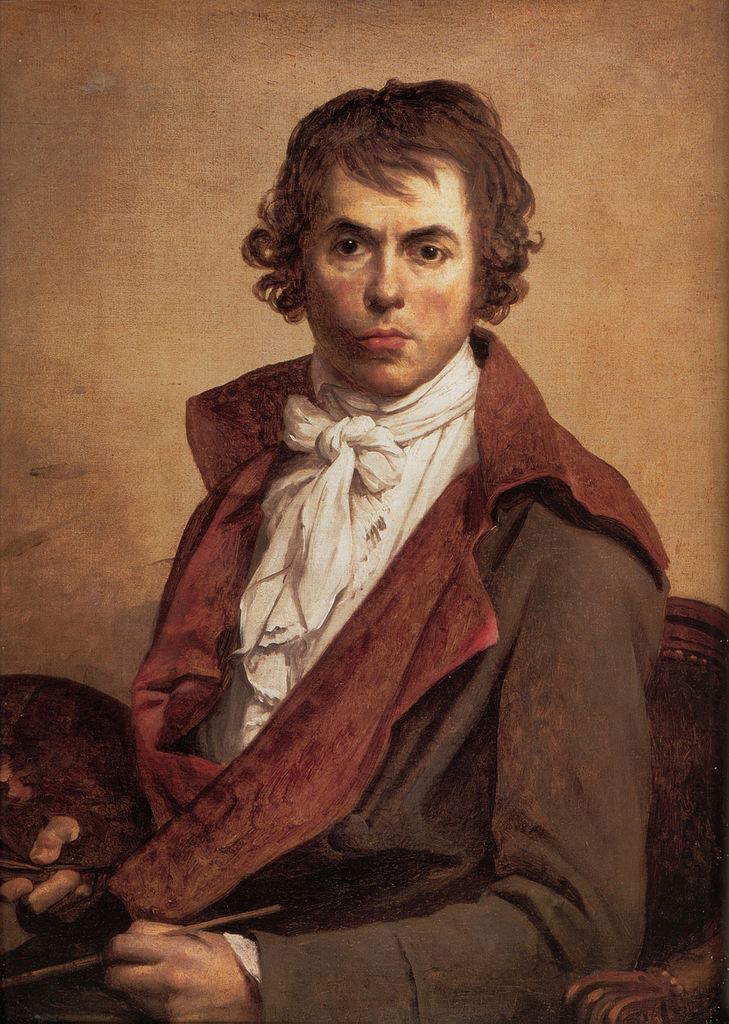
Jacques-Louis David, born in Paris on August 30, 1748, was the son of Louis-Maurice David and Marie-Geneviève Buron: his father was a wholesale iron merchant in Paris and his mother belonged to a family of master masons. David lost his father at the age of nine, so his uncle on his mother’s side François Buron, an architect, began to take charge of his nephew’s education. He initially studied rhetoric (study from speech and the organization of a discourse) at the Collège des Quatre-Nations. During his studies, David’s aptitude for drawing was evident, so his uncle decided to have him study architecture, hoping he would follow the family tradition. Having fully learned basic drawing techniques at the Académie de Saint-Luc, through family connections David met François Boucher, the king’s first painter, hoping he would become his teacher. Boucher, being ill and old refused the offer of a new pupil, recommending instead Joseph-Marie Vien (considered in France to be the forerunner of neoclassicism), so David entered Vien’s studio in 1766; in the same year he enrolled in the Académie Royale, a school that allowed him to compete for the Prix de Rome (competition for students in the arts: winners were entitled to a scholarship to go and study at the Academy of France, now the Mancini Palace, in Rome).
During his period of study at the Académie Royale from 1769 to 1773, David every year competed for the Prix de Rome, never coming in first place: these constant failures led him to feel contempt for academic institutions. Finally in 1774 he won the Prix de Rome: he left in 1775 with his teacher Joseph-Marie Vien, stayed in Italy for four years during which time he became a devotee of Renaissance painting, visiting Florence, Bologna, Parma, and became particularly fond of Caravaggio’s painting technique. During the first year of his studies he devoted much time to the practice of drawing, copying ancient sculptures. He also visited the ruins of Pompeii and Herculaneum unearthed during those very years.
In 1780 David returned to Paris, and decided to prepare himself to attempt to be exhibited at the Salon of the Academy (annual exhibition of painting and sculpture) in 1781. In order to enter the Salon, three works had to be submitted, which were judged by the Comte d’Angiviller: if the judgment was positive, he would have permission from the academy to exhibit his works publicly. David obtained an exhibition space at the 1781 Salon, and his paintings were noticed by critics who wrote positively about them, particularly Diderot who appreciated Belisarius asks for alms, writing, “every day I see him and I always think I see him for the first time.” The artist married Marguerite Charlotte Pécoul in 1782, by whom he had four children. With the generous dowry he received from his bride’s family, David was able to finance himself by opening his studio in the Louvre, where he also had quarters. With the opening he began to receive applications from young artists who wished to learn techniques from him, such as Anne-Louis Girodet, Jean-Germain Drouais, François-Xavier Fabre.
David, after his marriage, was able to return to Italy in 1783 accompanied by his wife and one of his pupils. In Rome he continued his painting activities by finishing The Oath of the Horatii, a painting intended for the Salon, and once finished he decided to exhibit the Horatii in an exhibition in Rome before his return to Paris: it achieved great success especially among painters and archaeologists, but the painting was not as successful at home, and David’s decision to change the size of the painting by making it larger (the size of history paintings had to be strictly square as required by the Academy) earned him a reputation as a rebellious and independent artist as well as a poor placement at the 1785 Salon. However, this did not prevent David from being successful, especially among artists of his age: this reputation exposed him to the jealousies of senior members of the Academy, who in 1786 canceled the Prix de Rome because all the candidates were David’s students.
David began to take an interest in politics: in September 1789 the artist, together with Jean-Bernard Restout, spearheaded the Dissident Academicians movement, which aimed to change the academic institutions of the Fine Arts: they went against the privileges of the Académie Royale, such as denying artists who were not members of the academy the opportunity to exhibit at the Salon. In 1790 he began the project for the painting The Oath of the Pallacord, a work that represented an important moment in the history of the Revolution: it showed the assembly gathered during the swearing in of their president Jean Sylvain Bailly, a project that remained only at an early stage (due to lack of funds it was never finished). David set himself at the head of the Commune des arts, a child of the political movement of dissident academics who in 1790 gained control of the Salon and the Académie Royale and established the Salon de la liberté in which David served as judge.
David’s artistic output during the Revolution is scarce: only unfinished portraits and a self-portrait (now in the Uffizi) have come down to us. A new theme was that of the martyrs of the Revolution as The Death of Marat: David was one of the last deputies to speak to him, and the National Convention (the political regime at the time) asked David to create a painting in his memory and to take charge of the funeral. In 1793, after the assassination of Marat, David finished his work, which was displayed in the convention hall, and also in the same year David and his wife separated over political differences: she supported the monarchy and asked for a divorce after he voted for the death of Louis XVI, actively participated in the regime of the Terror (the bloodiest phase of the French Revolution, which centered on the hunt for royalists), dealing with many interrogations and participating in trials against royalists, and also participated in the execution of Marie Antoinette by drawing her being led to the gallows (Marie Antoinette being led to the Gallows, drawing 1793).
David spent a period of imprisonment, arrested on August 2, 1794 for supporting Robespierre ’s political ideas (also arrested in July, accused of aspiring to dictatorship), and cleared of the charges was released thanks to the support of his students and ex-wife to whom he remarried in 1796. In 1795 he returned to exhibit at the Salon, where he showed two portraits of diplomats; the same year he began painting The Sabine Women, which he would finish in 1798, a work that was not exhibited at the Salon (David did, however, organize a paid exhibition open to the public). With the announcement of the Battle of Lodi (May 10, 1796) David began to feel admiration for Napoleon, so he decided to write to him to offer himself as an artist. Napoleon would try on more than one occasion to take David with him on his expeditions, failing since David refused his invitations. In 1800 the King of Spain, Charles IV (on good terms with France), commissioned David to paint a portrait of Napoleon for the Royal Palace. David created The First Consul crosses the Alps at the Great St. Bernard, a work that was an immediate success; later it was Napoleon himself who requested three copies.
In December 1803 David was made a knight of the Legion of Honor (a knighthood instituted by Napoleon Bonaparte), and the following year he obtained a commission for four paintings from Napoleon I (emperor from 1804 to 1815): The Coronation of Napoleon I, The Distribution of the Eagles, TheEnthronement, and TheArrival at the Hotel de Ville. Napoleon’s Coronation was on display during the Salon of 1808 where it achieved great success; Bonaparte was so pleased that he appointed David as an officer of the Legion of Honor.
After Bonaparte’s fall, the monarchy was restored in France, and David, concerned about his revolutionary and Bonapartist past, decided to secure his works and take refuge in Switzerland, and later moved to Brussels where he was officially found to be in exile in 1816 (all those who were part of the Convention that voted for the death of Louis XVI ended up in exile), and never returned to France. At age 75 he painted his last mythological-themed work, Mars Disarmed by Venus and the Graces, which was exhibited in Brussels in 1824 and later in Paris where it was a great success. In 1824 David was run over by a carriage and in 1825 suffered paralysis of the hands. He died the same year, on December 29, in Brussels.


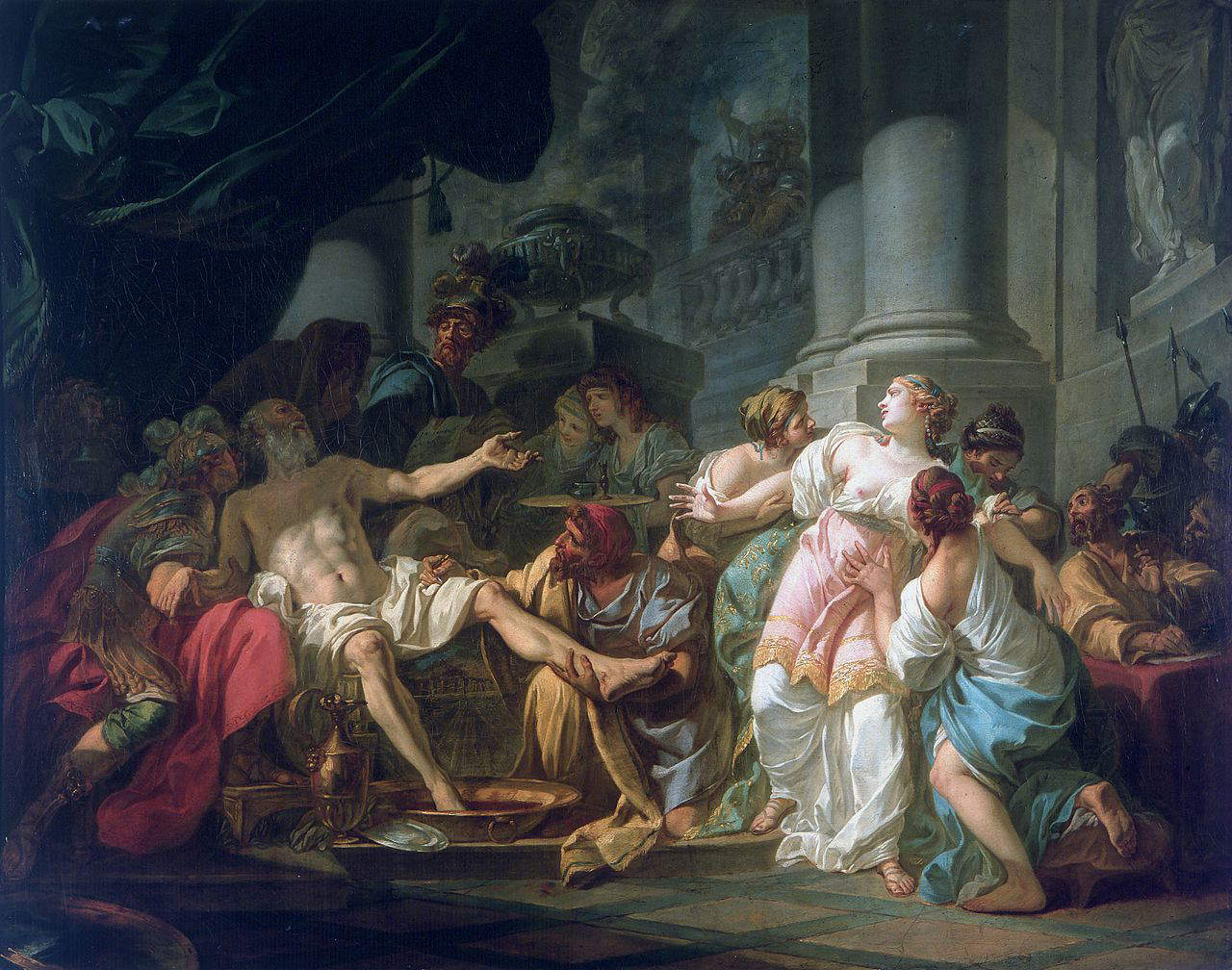


Jacques-Louis David’s works are characterized by majestic solemnity and fully reflect the neoclassical style. David did not always paint in the same way: in his early years it can be seen that his painting is still influenced by the Baroque and Rococo styles, the paintings have a very lively palette, and the scenes are lavish and exaggerated, not very harmonious; these characteristics are present in Minerva fighting Mars (1771) and The Death of Seneca (1773).
After the trip to Italy, David’s painting changes: his study at the French Academy in Rome and direct contact with antiquitiesinfluenced his way of representing scenes and especially the human figure. The light in David’s works changes and with it the colors; the discovery and study of new artists such as Caravaggio influences his depictions, making the environment and people more real, as in Belisarius asks for alms (1781).
David’s works begin to have geometric and perspectival reasoning, which goes to influence the meaning of the representation. In the Oath of Horatii (1784) he opts for a horizontal composition taken from the study of bas-reliefs; the scene has a geometric rigor that is clearly perceived: we observe a small courtyard; we can see in the background three arches that divide the environment; on the left we have three men (the three Horatii brothers) who are swearing an oath to their father (they will give their lives for the victory of Rome); on the right the female figures despair at the sacrifice of the three men; the drama of the scene is due to the poses: the three men on the left perfectly aligned hold each other, while the father standing in the center of the scene hands them swords, and on the right the female figures are depicted softly with swaying poses that contrast with the square, angular male bodies.
During the French Revolution his painting shifted from mythological representations to scenes related to reality-David began to paint the martyrs of the Revolution, people who fell for their country, men to be admired. The Death of Marat (1793) shows the young man assassinated in his bathtub. David does not present the moment of the murder, but the aftermath of the act: the silence and dramatic value given by the compositional simplification, invite the viewer to reflection. Among the martyrs painted by David is The Death of Young Bar ra (1794), a young drummer, Joséph Barra, who died at the age of 13 during the Vendée War; the painting was unfortunately not completed.
David, influenced by the political climate of the Restoration, conceived Le Sabine (executed between 1794-99) during his period of imprisonment; the work, which takes up Roman history, depicts the moment when the Sabine women interrupt the fighting between the Romans and the Sabines. David with this painting wanted to recover a social balance that had been lost during the Revolution; he wanted a reconciliation between the various political and social parts of France.
During the Napoleonic period David resumed painting the reality around him by exalting it, for example with the figure of Napoleon Bonaparte: David’s admiration was such that this feeling can be perceived in his canvases. Bonaparte Crosses the Great St. Bernard (1800) is a riot of majesty: it depicts the moment when the general crosses the Alps with the French army; the whole scene follows the general’s arm pointing toward the horizon; everything moves in that direction: the horse, the army, the wind that stirs both the coat and the horse’s mane and tail.
In his later years David returned to painting mythological themes, depicting nudity in a less elegant way, making the nude more real and vulgar, as in his version of Cupid and Psyche (1817), which during the exhibition scandalized the public who found it vulgar: precisely because Cupid’s naked body was too authentic. Mars disarmed by Venus (1824), David’s last masterpiece, is characterized by elegant and refined nudity: in fact, here the artist takes as his model the ancient nude typical of the statues he studied in his youth.
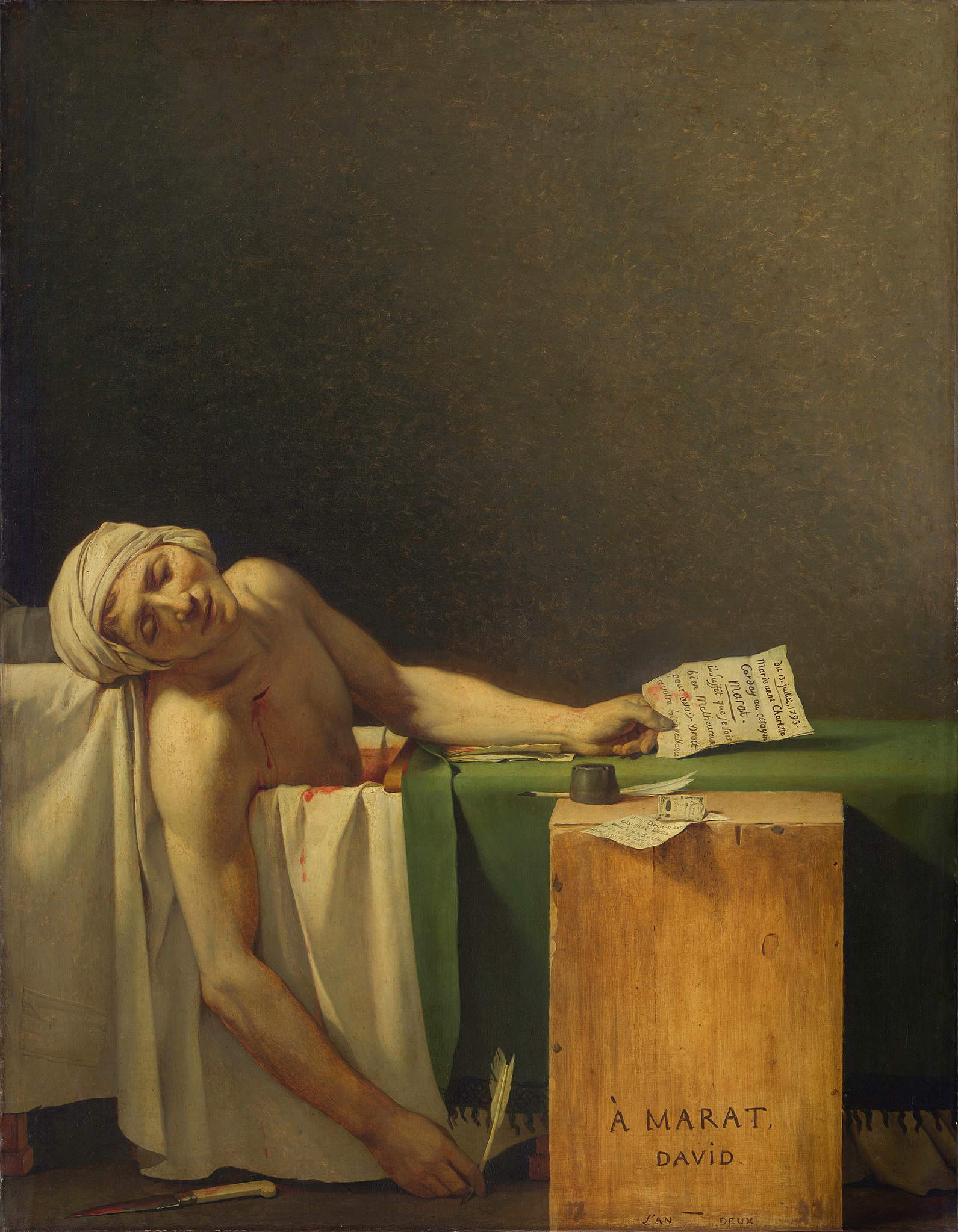
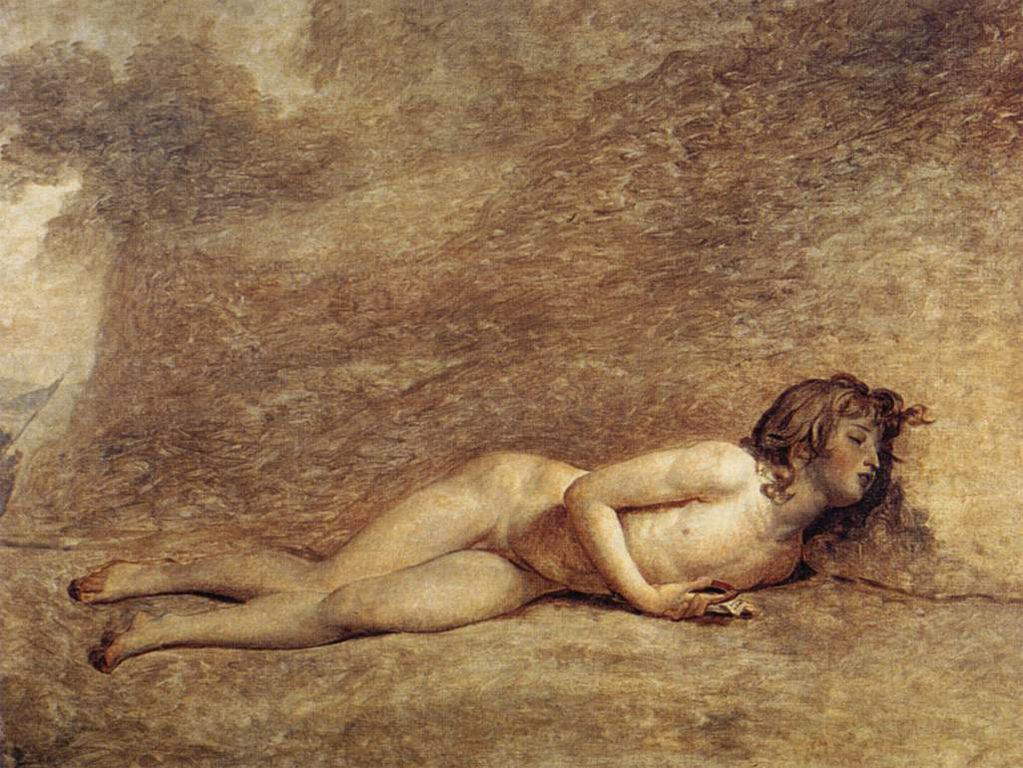

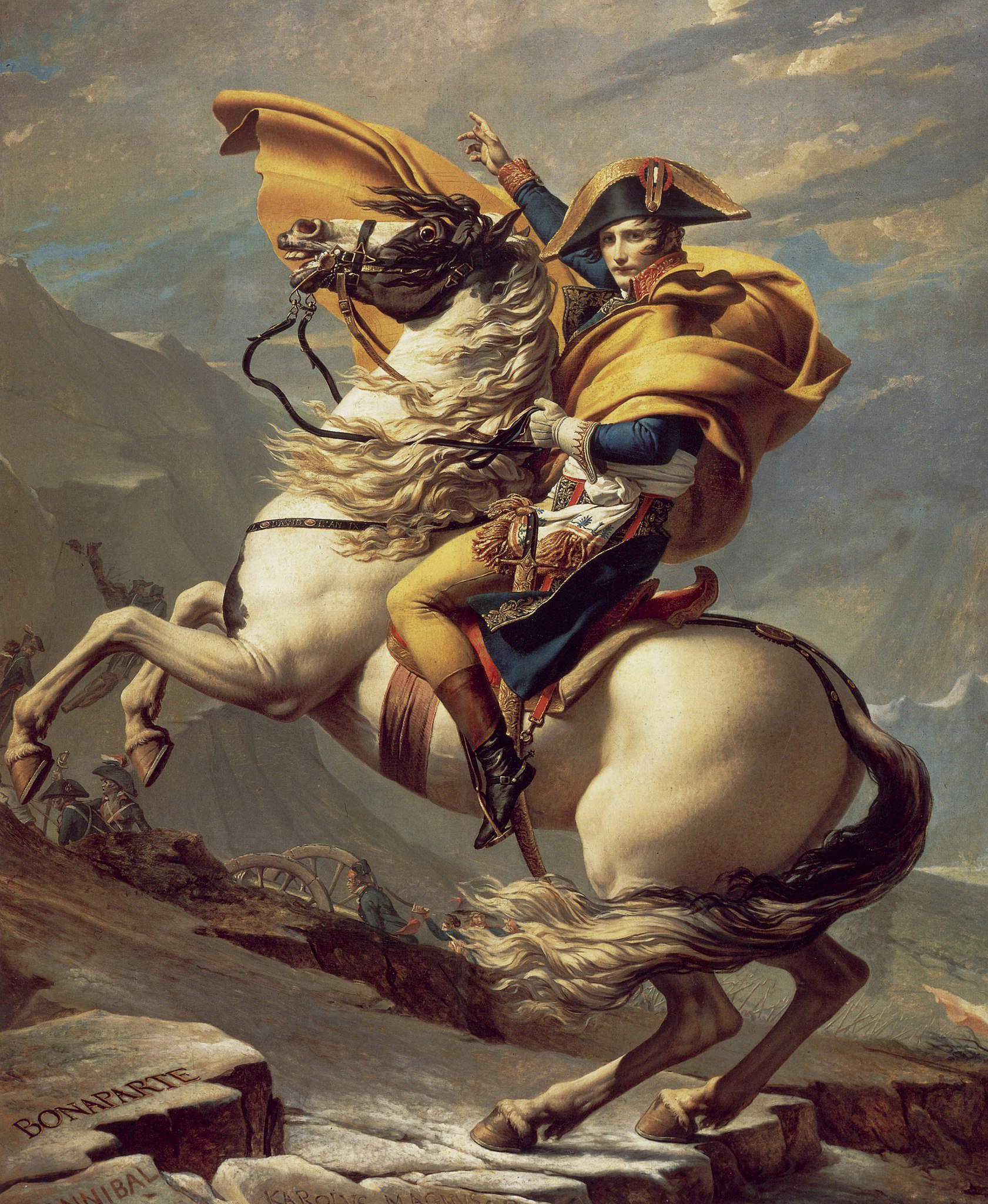
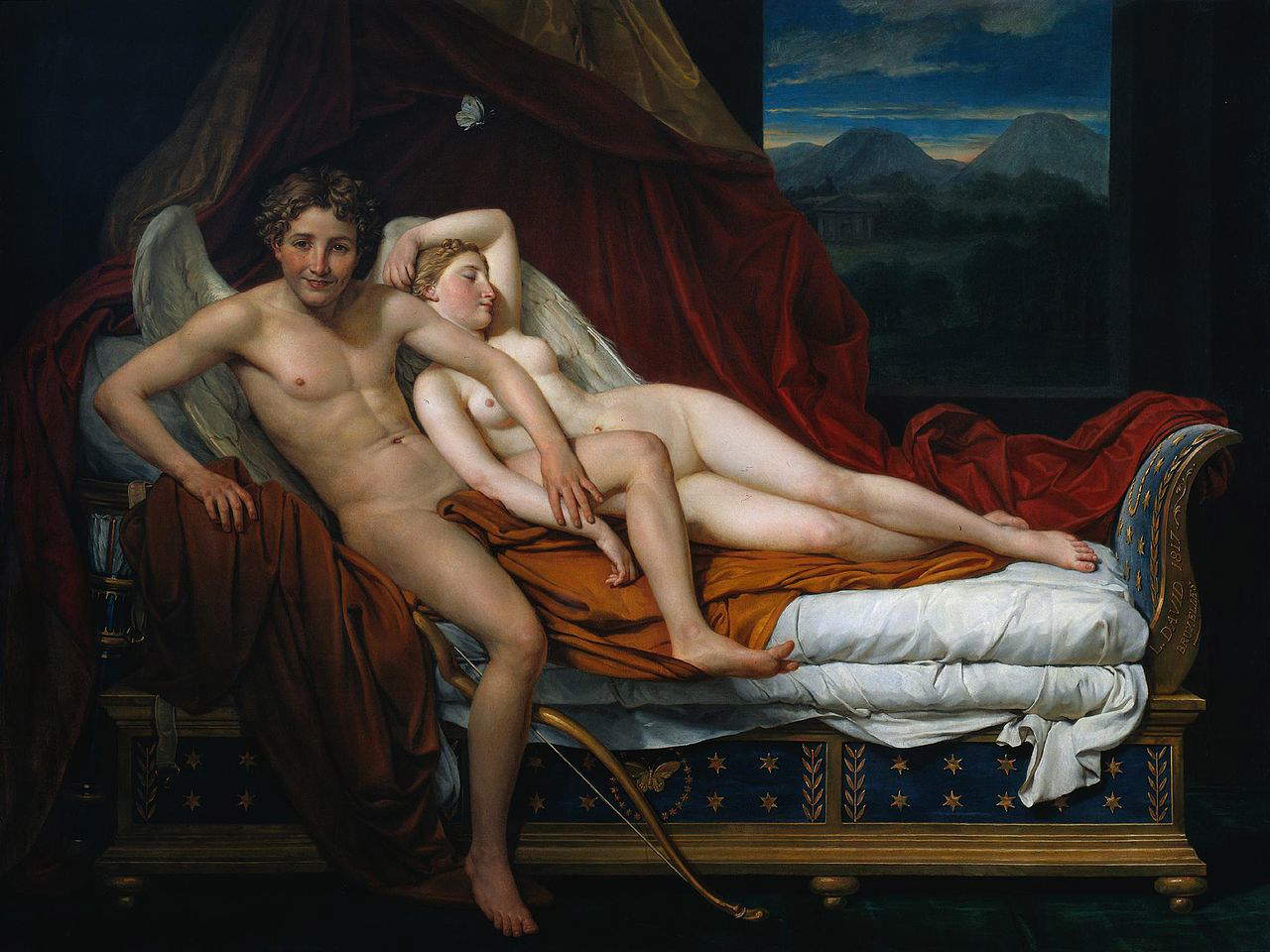

Most of Jacques-Louis David’s works can be found at the Musée du Louvre in Paris such as The Sabine Women and The Oath of the Horatii, also in France at the Château de Versailles many of his paintings can be found such as two of the replicas of Bonaparte Crosses the Great St. Bernard. In Lille (France) at the Musée des Beaux-Arts is Belisarius asks for alms.
In Vienna at the Belvedere Museum is the third replica of Bonaparte Crosses the Great St. Bernard. Some works (such as The Death of Marat) are at the Royal Museum of Fine Arts of Belgium (Oldmasters museum) in Brussels.
In Italy we have only two works: a Self-Portrait (1791) at the Uffizi Gallery in Florence and the Portrait of Zenalde and Charlotte Bonaparte (1821 replica) at the Napoleonic Museum in Rome.
The Death of Socrates is at the Metropolitan Museum in New York along with the Portrait of General Etienne-Maurice Gérard (1816). Also in the U.S. in Washington at the National Gallery of Art are Napoleon in his Work Cabinet (1812) and Portrait of Charlotte David (1813).
 |
| Jacques-Louis David, the great French neoclassical painter. Life, works, style |
Warning: the translation into English of the original Italian article was created using automatic tools. We undertake to review all articles, but we do not guarantee the total absence of inaccuracies in the translation due to the program. You can find the original by clicking on the ITA button. If you find any mistake,please contact us.